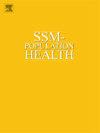Social determinants of where people die: A study of moderators and mediators using linked UK Census and mortality data
IF 3.1
2区 医学
Q1 PUBLIC, ENVIRONMENTAL & OCCUPATIONAL HEALTH
引用次数: 0
Abstract
Background
Where people die depends on many factors and is important to the quality of end-of-life care. Many people prefer to avoid end-of-life hospital admissions and yet hospital remains the most common place of death across high-income countries and is more likely for people who live in more deprived areas. This study examines moderators and mediators of socioeconomic inequality in place of death.
Methods
We used census data linked to mortality data for people who died in England and Wales between 2011 and 2017 to investigate the association between area-based income deprivation and death in hospital versus home, hospice, and care home. We tested moderators including age, sex, ethnicity, underlying cause of death and region, and mediating pathways through housing deprivation, living alone, and worse health.
Results
Among 34,230 decedents, after adjusting for age and sex, the proportion of deaths in hospital was higher in more deprived areas; 52.4 % (95 % CI: 51.2 %–53.6 %) and 46.7 % (45.5 %–48.0 %) for people living in the most and least deprived areas, respectively. This association was moderated by underlying cause of death; a social gradient was observed for deaths from cancer, dementia and ‘other’ causes but not for people who died from respiratory, cardiovascular, and sudden causes (F = 43.81; df (20), p = 0.0016). In a subsample of people who died from cancer, people living in the most deprived areas were more likely to live alone (36 % (95 % CI 30 %–41 %)) than those in the least deprived areas (19 % (15 %–23 %)), and this partly explained why they were more likely to die in hospital, accounting for 12.2 % of the total effect of income deprivation on death in hospital.
Conclusion
This study contributes novel findings that deepen our understanding of socioeconomic inequality in place of death. Improving support for people living alone in more deprived areas is identified as a potential way to reduce inequalities in place of death.
人们死亡的社会决定因素:一项使用英国人口普查和死亡率数据的调节因子和中介因子的研究
人们的死亡地点取决于许多因素,这对临终关怀的质量很重要。许多人宁愿避免临终住院,但医院仍然是高收入国家最常见的死亡地点,生活在更贫困地区的人更有可能死亡。本研究探讨了社会经济不平等的调节和中介在死亡的地方。方法:我们使用与2011年至2017年期间英格兰和威尔士死亡人数相关的人口普查数据,调查基于地区的收入剥夺与医院、家庭、临终关怀和养老院死亡之间的关系。我们测试了调节因素,包括年龄、性别、种族、潜在死亡原因和地区,以及住房剥夺、独居和健康状况不佳等中介途径。结果34230例死亡中,经年龄和性别调整后,贫困地区住院死亡比例较高;生活在最贫困和最不贫困地区的人分别为52.4%(95%置信区间:51.2% - 53.6%)和46.7%(45.5% - 48.0%)。这种关联被潜在的死亡原因所缓和;死于癌症、痴呆和“其他”原因的人有社会梯度,但死于呼吸系统、心血管和突发原因的人没有(F = 43.81;Df (20), p = 0.0016)。在死于癌症的人的子样本中,生活在最贫困地区的人比生活在最贫困地区的人更有可能独自生活(36% (95% CI 30% - 41%)),而生活在最贫困地区的人(19%(15% - 23%)),这部分解释了为什么他们更有可能死于医院,占收入剥夺对医院死亡总影响的12.2%。结论本研究提供了新的发现,加深了我们对社会经济不平等的理解。改善对贫困地区独居者的支持被确定为减少死亡不平等的潜在途径。
本文章由计算机程序翻译,如有差异,请以英文原文为准。
求助全文
约1分钟内获得全文
求助全文
来源期刊

Ssm-Population Health
PUBLIC, ENVIRONMENTAL & OCCUPATIONAL HEALTH-
CiteScore
6.50
自引率
2.10%
发文量
298
审稿时长
101 days
期刊介绍:
SSM - Population Health. The new online only, open access, peer reviewed journal in all areas relating Social Science research to population health. SSM - Population Health shares the same Editors-in Chief and general approach to manuscripts as its sister journal, Social Science & Medicine. The journal takes a broad approach to the field especially welcoming interdisciplinary papers from across the Social Sciences and allied areas. SSM - Population Health offers an alternative outlet for work which might not be considered, or is classed as ''out of scope'' elsewhere, and prioritizes fast peer review and publication to the benefit of authors and readers. The journal welcomes all types of paper from traditional primary research articles, replication studies, short communications, methodological studies, instrument validation, opinion pieces, literature reviews, etc. SSM - Population Health also offers the opportunity to publish special issues or sections to reflect current interest and research in topical or developing areas. The journal fully supports authors wanting to present their research in an innovative fashion though the use of multimedia formats.
 求助内容:
求助内容: 应助结果提醒方式:
应助结果提醒方式:


